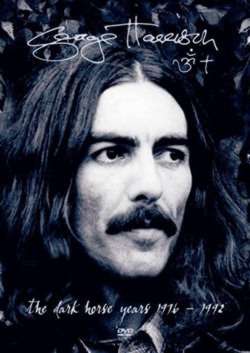Elly Roberts reviews
Parlophone
- Cert:

- Cat.no: 5441039
- Running time: 76 minutes
- Year: 2004
- Pressing: 2004
- Region(s): All, PAL
- Sound: DTS 5.1, Dolby Digital 5.1, Stereo (depending on source)
- Languages: English
- Subtitles: English, French, Italian, German, Spanish, Portuguese and Dutch on spoken word sections
- Widescreen: 1.78:1
- Disc Format: DVD 9
- Price: £15.99
- Rating: 6/10
- Extras:Booklet containing extensive liner notes. A short history of the Dark Horselabel by Olivia Harrison & extensive photo selection in a deluxe 28-page booklet.


Mahatma Ghandi once said, “Create and preserve the image of your choice”.
What appropriate words for describing George Harrisons career and thispackage. Harrison was the first ex-Beatle to score a number one hit, withMy Sweet Lord in January 1971. His last single chart-entry was with thevery same song, re-issued in January 2002, following his death in November2001.
He started as hed finished, as it also went to the top again. Sandwichedbetween those were varying degrees of success. The Beatles had long gone bythe time he began to think of his future as a performer. Know as the Quiet One,he was gradually coming to the end of his contractual obligations with EMI/Parlophoneby 1976, (which had run since 1962 negotiated by Brian Epstein), so he wasready for a new challenge an opportunity to find a haven for his newfound freedom as a bone fide solo artist.
What better way to start a new life than have your own recording label. It wasactually created in 1974, but took two years to get off the ground. He namedit Dark Horse. To fully appreciate this DVD, I recommend you read theexcellent booklet beforehand, as it gives a more detailed account of theprocess which brought about its creation. The roster of artists he recruitedwas impressive including Ravi Shankar, Splinter, and ex-Joe Cocker guitaristHenry Mc McCullough.
In the booklet, his wife Olivia leads us in, followed by a text by David Fricke.
The film, in four parts, chronicles Harrison finally breaking free from theFab Four, as he comes of age from the shadow of his former band mates.
It comes across as some kind of liberation as he followed his heart in termsof musical direction. He was also keen to get back to real music realguitars, real drums, real bands as he saw a rapid decline in the quality ofsongwriting and production. Interviews reveal little of himself, but heopenly discusses his development, aspirations, along with playing with hislong-time friend Eric Clapton, with whom he toured fronting Claptons band inthe early 1990s.
Harrison was thrilled to be playing live again, considering The Beatles hadquit touring by December 1966, that came as no surprise. Happiness is arecurring theme, and we are left to our own conclusions on that one. Here heperforms the Beatles Taxman, Cloud Nine, Devils Radio (a referenceto continual rumours about him) and Cheer Down. All this footage ispreviously unreleased, though not exceptional as a performance. Much to mysurprise, he proves to be a great slide guitarist.
The promo video section is quite sad by todays standards, as the concepts andproduction are unbelievably naff, particularly the Crackerbox Palace shoot.That said, theres the inevitable fun formula which featured prominentlyin Beatles films. Finally, we get some footage from the film Shanghai Surprise, which he contributed to, with snippets of Madonna and Sean Penn.This will sit nicely alongside my Beatles DVDs.
The DVD was previously only available as part of the Dark Horse box set.
Check out the following on CD:
Elly Roberts passed away in 2011, but he was a man who was so passionate about all types of music and loved meeting his musical heroes, such as Mick Hucknall at a book signing at the Trafford Centre, Manchester in 2007.
A former teacher and also a music journalist, DJ and radio presenter on local community station Calon FM, plus appearances on BBC Radio Wales, BBC Radio Cymru and BBC Radio 2, Elly started doing reviews for DVDfever.co.uk in 2004 and he did the majority of the CD and concerts reviews on the website.
I know also that he loved getting away for the summer to Spain and I hope that wherever he is now he is enjoying the hot sunshine and, as one of his friends has said on his Facebook page, that he is interviewing his musical heroes.
